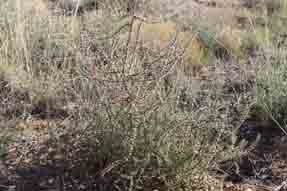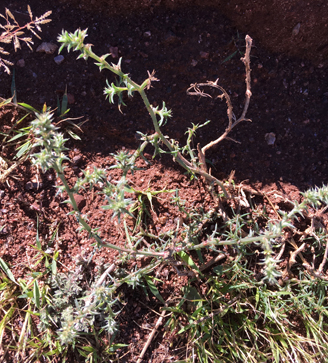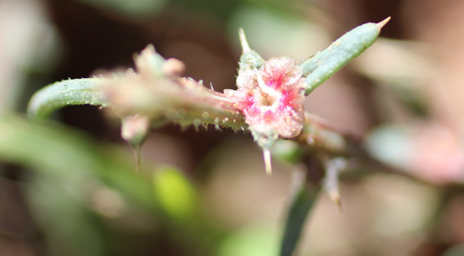
Location
Beside church wall (N35D32'59.279 X 105D41'21.1888)
Flowers first observed: 9/12/17
The Plant
 |
 |
The Flower

Distribution
"Kali tragus is native to Eurasia, but in the 1870s, it appeared in South Dakota when flaxseed from Russia turned out to be contaminated with Kali seeds. Although it is the best-known of this group of weeds, and was at first thought to be a single well-defined species, it now is known to have included more than one species plus some hybrids. This has led to taxonomic confusion in dealing with species in the genera Salsola and Kali in America. Recent studies show that the population that once was assigned to Salsola tragus really includes three or more morphologically similar species that differ in flower size and shape. The group was widely assigned to the family Chenopodiaceae, but the Chenopodiaceae – including the genera Kali and Salsola – have since been included in the Amaranthaceae. They now are allocated to the Salsoloideae, a subfamily of the Amaranthaceae.[3]
Kali tragus proved to be highly invasive as an introduced species and rapidly became a common ruderal weed of disturbed habitats in many regions of North America, particularly in the Midwest. The species also has become naturalized in various regions of Central and South America and in parts of Southern Africa and Australia.[4] It now occupies a wide variety of habitat types in those regions and often is the first or even the only colonizer in conditions where no local species can compete successfully. Because of its preference for sand and its tolerance of salinity, it commonly grows along sea beaches as well as in disturbed grassland and desert communities, especially in semiarid regions.[5]" (Wikipedia)
Description
"Kali tragus is an annual forb. In habit, the young plant is erect, but it grows into a rounded clump of branched, tangled stems, each one up to about a metre long. Depending on the plant's genetics and condition, the leaves and stems may be green, red, or striped, and they may be hairless or pubescent. The leaves are tipped with spines that in most varieties are so sharp that the plants are best handled with gloves and other suitably protective clothing, though some genetic variants have only a hair at the tip. On the young plant, leaves may be more than 5 cm long, succulent and more or less cylindrical; these juvenile leaves are deciduous and drop off as the plant matures. The leaves of the mature plant are persistent, leathery, broader and shorter than the young leaves (seldom more than 1 cm in length), rigid and spine-tipped. They remain on the stem till the plant dies at the end of the season. In the axil of the mature leaf, there are two leaf-like bracts with a flower between them. The flower lacks petals, but is surrounded by a disk of wide, winged sepals, whitish to pink in color.[6]" (Wikipedia)
"The plant becomes woody as the fruits develop. As they ripen, the plant begins to die, dries out and becomes brittle. In that state the base of the stem breaks off easily, particularly in a high wind. The plant then rolls readily before the wind and disperses its seeds as a tumbleweed.[6]"(Wikipedia)
Ethnobotanical Uses
Food & Medicine:
"Extremely tasty as cooked spinach - eat whole plant up to 5 inches tall- double boil to remove bitterness and only eat young plants. Young plants also for sheep and horse feed. Navajos used it to treat influenza, small pox, and insect bites." (SEINet)
Internet Links